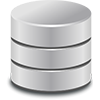In pure mathematics a value does not have a space limit for its representation, however, computers generally work with a fixed number of bits. The basic unit of information on a computer is called a bit. With a bit you can represent only one value of two possible different values; for example: zero or one, false or true, black or white, down or up, no or yes, etc.
Media capacity and information capacity
A large amount of data can contain very little information. That is, the amount of data and the amount of information are different characteristics used in different areas related to information, but historically the name "quantity of information" was used in the meaning of "data volume", and to measure the amount of information used the names "information entropy" and "value of information".
Media capacity and data volume measurements
They are used to measure the capacity of media, storage devices, and to measure data volumes.
Units of measurement of the amount of information
Used to measure the amount of information in the amount of data. Information entropy.
The primary unit
The primary characteristic of the amount of data is the number of possible states. The primary unit of measurement of the volume of data is 1 possible state (value, code).
Secondary units
- The secondary characteristic of the volume of data is a discharge.
- The capacity (volume) of one discharge can be different and depends on the basis of the coding system used.
- One-level capacity in binary, trinity and decimal coding systems:
- One binary discharge (bit) has two mutually exclusive possible states (values, code).
- One trinity (trit) has 3 mutually exclusive possible states (values, code).
- One decit (decit) has 10 mutually exclusive possible states (values, codes).
Tertiary units
The tertiary characteristics of the data volume are different sets of discharges. The capacity of many discharges is equal to the number of possible states of this set of discharges, which is determined in the combinatorics, equals the number of placements with repetitions.
Logarithmic units
When some values, including the amount of data, are demonstrative functions, in many cases, it is more convenient to use logarithms of these values rather than the values themselves.
Data Storage Conversion Table
Multiples of bits
Decimal
| Value |
SI |
| 1000 (103)
| kilobit (kbit) |
| 10002 (106) |
megabit (Mbit) |
| 10003 (109) |
gigabit (Gbit) |
| 10004 (1012) |
terabit (Tbit) |
| 10005 (1015) |
petabit (Pbit) |
| 10006 (1018) |
exabit (Ebit) |
| 10007 (1021) |
zettabit (Zbit) |
| 10008 (1024) |
yottabit (Ybit) |
|
Binary
| Value |
IEC |
| 1024 (210)
| kibibit (Kibit) |
| 10242 (220) |
mebibit (Mibit) |
| 10243 (230) |
gibibit (Gibit) |
| 10244 (240) |
tebibit (Tibit) |
| 10245 (250) |
pebibit (Pibit) |
| 10246 (260) |
exbibit (Eibit) |
| 10247 (270) |
zebibit (Zibit) |
| 10248 (280) |
yobibit (Yibit) |
|
Multiples of bytes
Decimal
| Value |
Metric |
| 1
| byte (B) |
| 1000 |
kilobyte (kB) |
| 10002 |
megabyte (MB) |
| 10003 |
gigabyte (GB) |
| 10004 |
terabyte (TB) |
| 10005 |
petabyte (PB) |
| 10006 |
exabyte (EB) |
| 10007 |
zettabyte (ZB) |
| 10008 |
yottabyte (YB) |
|
Binary
| Value |
IEC |
| 1
| byte (B) |
| 1024
| kibibyte (KiB) |
| 10242 |
mebibyte (MiB) |
| 10243 |
gibibyte (GiB) |
| 10244 |
tebibyte (TiB) |
| 10245 |
pebibyte (PiB) |
| 10246 |
exbibyte (EiB) |
| 10247 |
zebibyte (ZiB) |
| 10248 |
yobibyte (YiB) |
|
